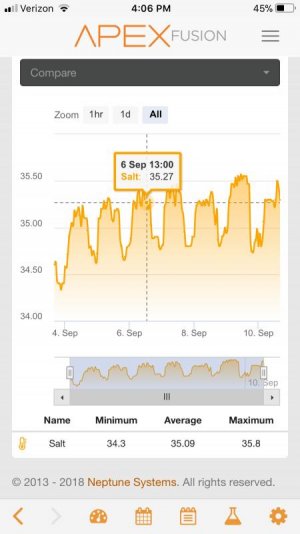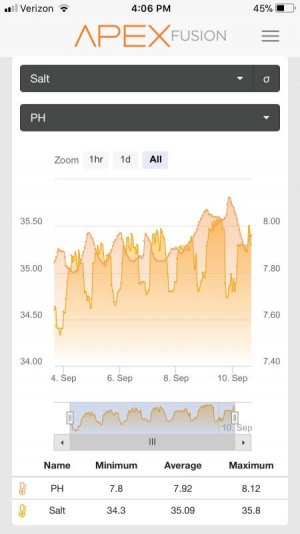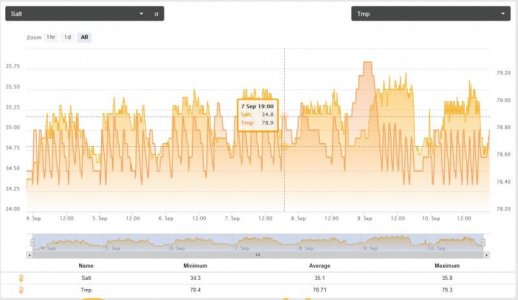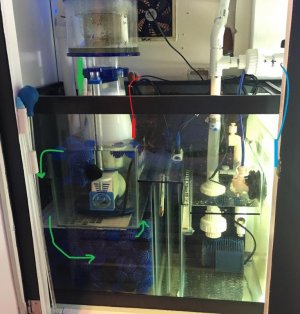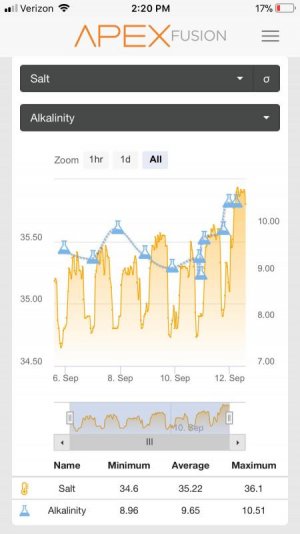reefinmike
New member
Hey all, I have finally seen some success after calibrating my apex's salinity probe for the 4th time. If you care to see the troubles I was having, you can see them here http://www.reefcentral.com/forums/showthread.php?t=2682223. My salinity(conductivity, I know...) probe has showed somewhat promising results since re-calibrating 8 days ago however I am curious about some trends I am seeing. It seems to be trending upwards and I'm also seeing a fairly predictable dip every day from 5/6pm to 1/2am. I'm fighting low PH from high household co2(windows open weather the past two days!!) but the change in PH through the day seems to correlate with the drop in salinity. My kessils are on from 2pm-2am, two sets of t5 turn on 6-9pm and 9pm-1am. This also seems to coincide precisely with the dips. The ballasts and associated wiring are on top of my canopy and a minimum of two feet away from the probe wire. My ATO solenoid also tends to be off 8pm-12a. My water level remains very consistent, my ato kicks on about once an hour adding ~4 ounces at a time to a 110g system. The systems temperature remains pretty consistent within a .5F range with the heater kicking on 6-8x a day tending to be off between 6pm to 3/4am. The temp while the lights are on doesn't rise above the max hysteresis the heaters heat the tank to the rest of the day. The only other electronic on a predictable schedule is the fuge light and UV on from 2am-2pm. The probe is not in the same sump compartment as the temp probe, I put it in a dark corner of the fuge because there are no bubbles and it's furthest away from other electronics/cords there. The fuge currently struggles to keep a golf balls worth of cheato alive in a super low nutrient environment so I wouldn't think it would have to do with a sudden jump in fuge PH.
Any opinions on what could be causing the predictable dip? anyone else experiencing their probe readings slowly creeping up over time? I sure hope the probe will "settle in" and stop rising. The rising trend did dip last night but that may have to do with a small 7 gallon water change(35ppt) and alk dose I did last night. I would also be grateful for any general tips/advice for reliable, consistent probe readings, probe care and calibration tips/frequency. I was bummed that the apex EL came out literally the day I opened my apex wifi and even more bummed when the only useful perk of my purchase proved to be so unreliable. I would eventually like to tighten the alarm parameters and use the probe as a third layer of safety to my ATO system.
Any opinions on what could be causing the predictable dip? anyone else experiencing their probe readings slowly creeping up over time? I sure hope the probe will "settle in" and stop rising. The rising trend did dip last night but that may have to do with a small 7 gallon water change(35ppt) and alk dose I did last night. I would also be grateful for any general tips/advice for reliable, consistent probe readings, probe care and calibration tips/frequency. I was bummed that the apex EL came out literally the day I opened my apex wifi and even more bummed when the only useful perk of my purchase proved to be so unreliable. I would eventually like to tighten the alarm parameters and use the probe as a third layer of safety to my ATO system.

